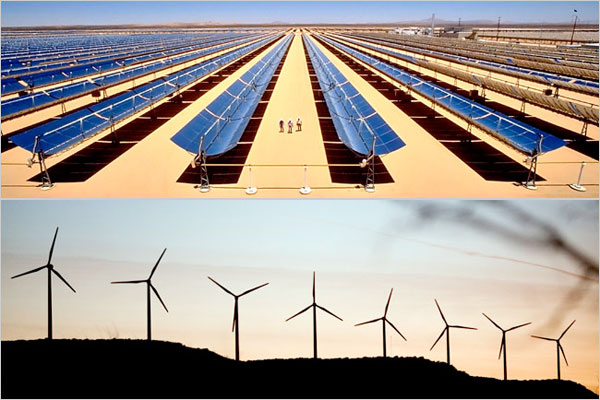 California and Texas: Renewable energy's odd coupleOct 17, 2009 - Kate Galbraith - The New York Times
Texas cares little for environmental niceties. Its governor, Rick Perry, bashes the Environmental Protection Agency at every opportunity, and recently branded the climate bill that passed the House of Representatives a “legislative monstrosity.” Yet the oil-and-gas state has nonetheless emerged as the nation’s top producer of a commodity prized by environmentalists: wind power. Eager developers are covering its desolate western mesas with giant turbines. The world’s largest wind farm began operations in Texas this month, and the state now has close to three times as much wind capacity as Iowa, the second-ranked state. This achievement puts Mr. Perry’s state in odd company. The race for clean-energy leadership is on — and big red Texas is going head-to-head with the gung-ho greens of California. That state has thrown itself into solar power and now leads the nation by a huge margin; it has also aggressively pursued energy efficiency. In the absence of sustained federal action to support clean energy and fight climate change, Texas and California are serving as important policy laboratories. Now, as the United States Senate considers the best ways to accelerate the use of renewable technologies — with the full support of the Obama administration — lawmakers might do well to look at those states. “These policies we come up with will last for decades, and we want/need to make sure policy makers think it through and realize that there are several paths to success,” Michael Webber, associate director of the Center for International Energy and Environmental Policy at the University of Texas, wrote in an e-mail message. Texas’s secret, besides strong winds and lots of land, is its lack of regulation. Wind developers rave about the fact that, in essence, they need few state permits to build a turbine farm. They deal mainly with local officials, who are generally permissive (energy, after all, is a well-loved commodity in Texas). California, by contrast, has all but stifled wind developers. The state built several big wind farms in the 1980s — but has added very few since, because of the cost and delays of complying with stringent state environmental regulations. The early turbines killed thousands of birds, for instance, and that memory lingers. Such snags are a key reason California has turned to solar power. It’s more expensive than wind, but plastering rooftops of homes and businesses with panels takes up no extra land. There is still plenty of paperwork involved, but rooftop solar largely avoids regulatory snarls (although there is the occasional only-in-California court battle between tree lovers and solar-energy lovers). The regulatory hurdles are also why the state has aggressively pushed energy efficiency, which is the most cost-effective way to reduce dependence on oil and gas. Strict building codes and energy-saving requirements for home appliances and light bulbs — measures that have been largely ignored by Texas — make an excellent fit for California, where residents are used to being regulated. Despite their vast differences, Texas and California do share one approach: each has a renewable electricity mandate, requiring that a certain amount of their electricity come from renewable sources by a given year. This policy, clunkily called a “renewable portfolio standard,” is in place in about half the states. Congress is considering one for the nation too: In June, the House passed a bill that would require 20 percent of utilities’ electricity by 2020 to come from a combination of renewable sources and efficiency improvements. The Senate is considering an energy bill that includes a somewhat weaker requirement (along with a separate, hotly debated climate bill). But here again, Texas and California have behaved very differently. Texas set a strong renewable energy requirement back in 1999 (when George W. Bush was governor) — and quickly exceeded it. Last year, 5 percent of the state’s electricity came from wind power. California set a very high bar, requiring big utilities to get 20 percent of their electricity from renewable sources next year, although they are not expected to meet it. The varied outcomes come back to a key difference: regulation. California is struggling to build large solar thermal plants in the desert, which are in some cases opposed by environmentalists — the very groups that are also hoping to combat climate change. In Texas, the birds and beasts may suffer, but the projects get built. Laying transmission lines — the wires necessary to carry clean energy to the cities — is much easier in Texas, analysts say, although Southern California is inching forward on some projects. Much more progress will be needed — in all states — if the nation is serious about transforming its energy supplies. Renewable energy now accounts for just 9.5 percent of the nation’s electricity supply — much of it from decades-old hydropower plants. Congress has already provided help in the form of tax credits for renewable energy, but developers say it is not enough. As states’ policy makers and the federal government accelerate work on wind, solar, biomass and even the still distant ocean-power technologies, some will prefer their policies more Texan, and some more Californian. Both have advantages — in their own, entirely different ways. |
Email this page to a friend
If you speak another language fluently and you liked this page, make
a contribution by translating
it! For additional translations check out FreeTranslation.com
(Voor vertaling van Engels tot Nederlands)
(For oversettelse fra Engelsk til Norsk)
(Для дополнительных
переводов проверяют
FreeTranslation.com )


